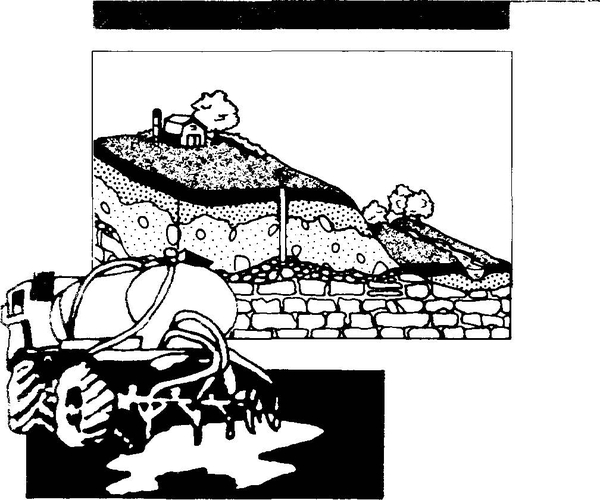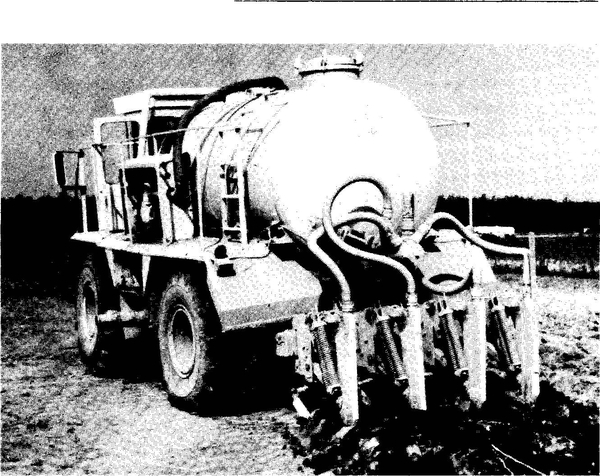Municipal sludges are the natural end products of a microbial food chain in the wastewater treatment process. Microbes feed on organic components of waste until they can no longer derive energy from it. At this point, sludge consists of mostly cellular material and stable degradation products that are considered safe for application to agricultural or forest lands.
If properly managed, land application is an excellent way to dispose of sludge. Waste can be applied at rates to meet crop nutrient requirements without harming the environment. Both the waste generator and the crop producer benefit from this recycling system. Humans and animals are natural waste generators, and land application makes it possible to recover the valuable components of waste as a usable resource.
Sludges contain many nutrients necessary for plant growth and development (Table 1) and organic matter that can improve the soil tilth. Applying sludge in accordance with the nutrient requirements of the crop and USEP A guidelines poses little risk to the environment or public health. Sludge is often provided without charge. Its use can therefore reduce fertilizer bills and increase the profitability of crops. When sludges are disposed of in other ways, the valuable nutrients they contain cannot be recovered. Concerns about applying sludges to land include the potential for applying too much or too little of each nutrient, the presence of toxic constituents, and problems with odors or insects. Sludges contain nutrients that are beneficial to plants, but heavy metals or other potentially toxic substances may also be present. These substances must be reduced or confined to levels that are considered safe for both agricultural and forest crops and soils.
| Metal | Parts Per Million |
|---|---|
| Nitrogen* | 2.6 |
| Phosphorus* | 1.6 |
| Potassium* | 0.2 |
| Lead | 335.0 |
| Zinc* | 1,750.0 |
| Copper* | 475.0 |
| Nickel | 37.0 |
| Cadmium | 11.0 |
| Chromium | 380.0 |
| Mercury | 5.0 |
*Nutrients essential for plant growth. ↲
Source: Agricultural Use of Munidpal and Industrial Sludges in the Southern United States. L. D. King. Southern Cooperative Series Bulletin 314, North Garolina State University.
Application Sites
Sludges can be applied successfully on agricultural land throughout the state. Generally, soils must be reasonably deep, well drained, and agriculturally or silviculturally productive. They must meet required buffer or setback restrictions. Landapplication programs have been successful in each of the geographic regions of the state.
Sludges can be applied legally to either privately or publicly owned land. Both sites are subject to preapproval by the North Carolina State Department of Environment, Health, and Natural Resources (NCDEHNR). The Department's Division of Environmental Management (DEM) must issue a permit before sludge can be applied. Before issuing a permit, a member of the division evaluates each site to verify its suitability for waste applications.
Land-applied sludge programs must be managed in accordance with requirements established by the United States Environmental Protection Agency (USEPA) and the Department of Environment, Health, and Natural Resources. For more information, see Bulletin 314, Agricultural Use of Municipal and Industrial Sludges in the Southern United States, and the US EPA Design Manual for Land Application of Sludge. Programs described in these publications are designed so that:
- Valuable agricultural nutrients can be returned to the land;
- Groundwater and surface water quality are maintained;
- No significant health or nuisance problems occur;
- Future use of sludge-treated land for reasonable activities is not restricted.
Obtaining a Permit
The waste producer is responsible for obtaining all necessary permits to apply waste. Permit applications must include an analysis of the waste's nutrient and metal levels, potential toxicity, and liquid and solids content. If the waste analysis indicates that land application is possible, the waste producer must identify suitable sites. This process requires obtaining topographic, location, and soil maps of each site; preparing descriptions of soil profiles; and developing a site-management and monitoring plan to optimize waste-management activities and ensure that environmental quality and public health are protected. After the land application permit is issued, the waste producer is responsible for the continued operation and monitoring of the facility. Typically, waste, soil, and vegetation must be sampled; groundwater and surface water may also be monitored.
Health and Environmental Concerns
Disease-Causing Organisms
Only sludges treated by digestion or chemical stabilization to reduce pathogen levels and the potential for disease transmission can be applied to land. Land application further aids in destroying pathogens by exposing them to sunlight, the soil environment, and drastic temperature changes. Sludge-application sites are restricted to general public access for 12 months after the sludge has been applied and three months for grazing animals. Only crops used for animal feed can be grown on sludge-application sites and the permit requires an 18-month lag between sludge application and growth of crops for human consumption.
Heavy Metals
Lead, zinc, copper, nickel, cadmium, chromium, and mercury are the heavy metals sometimes found in sludge. The total quantity of a heavy metal that can be applied to agricultural or forest land is regulated by guidelines from the USEP A and from the Department of Environment, Health, and Natural Resources. These maximum accumulative metal levels are conservatively calculated both to protect against metal toxicities in crops and to prevent the movement of heavy metals into the food chain.
Federal and state regulations require that the soil pH be adjusted to 6.5 or more before sludge is applied. This requirement is an additional safeguard that limits metal uptake by plants and promotes optimum crop yields in most soils.
Water Quality
Both surface water and groundwater must be protected in a land-application program. Nitrogen and phosphorus are the primary water contaminates from sludges. Both nutrients are necessary for plant growth and can be controlled in an environmentally sound manner. Surface waters can be protected by using conservation practices that reduce erosion and prevent the movement of sediments and accompanying nutrients from the site of application to ponds, lakes, or streams. Groundwater contamination by nitrogen may occur if the nitrogen applied in sludge is greater than the crop requires.
The Department of Environment, Health, and Natural Resources in North Carolina restricts sludge application to sites where surface runoff is minimized and restricted from reaching surface water bodies, drainage ditches, and other impoundments. Further, application within l 00 feet of wells is prohibited to reduce the potential for waste constituents to move from the soil into groundwater.
Insects and Odors
Sludge treatment not only reduces pathogen concentrations but minimizes odors by reducing the amount of biodegradable organic material in the sludge. Land application of treated sludge at rates suitable for agriculture or silvaculture normally does not cause problems with odors, insect vectors, or other nuisances. Odor and insect problems generally occur when raw, unstabilized wastes are applied without regard for permit requirements.
Sludges may be applied to the soil surface or injected into agricultural or forest land. Surface-applied sludge may be disked into the soil, (Figure 1), although incorporation is not required. Injection of sludge is generally the best method for retaining nutrients on the site. It minimizes the potential for insect and odor problems and may be more aesthetically desirable in a sensitive environmental situation. However, injection of sludges on established pasture sites may damage the pasture, (Figure 2), and landowners may therefore not permit this practice. Surface application of sludge has been widely practiced throughout North Carolina and the United States.
Conclusion
Proper land application of municipal sludges can protect public health, maintain or improve environmental quality, and encourage the beneficial use of wastes. Land application of sludges must be permitted by the North Carolina State Department of Environment, Health, and Natural Resources in compliance with state and federal regulations.
Prepared by:
A R. Rubin, Extension Agricultural Engineering Specialist
L. M. Safley, Professor of Biological and Agricultural Engineering
J.P. Zublena, Specialist in Charge, Soil Science Extension
7,000 copies of this public document were printed at a cost of $750, or $.11 per copy.
Publication date: Jan. 1, 1991
Reviewed/Revised: June 5, 2024
AG-439-03
N.C. Cooperative Extension prohibits discrimination and harassment regardless of age, color, disability, family and marital status, gender identity, national origin, political beliefs, race, religion, sex (including pregnancy), sexual orientation and veteran status.



